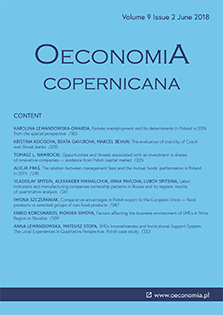Female unemployment and its determinants in Poland in 2016 from the spatial perspective
Female unemployment and its determinants in Poland in 2016 from the spatial perspective
Author(s): Karolina Lewandowska-GwardaSubject(s): Gender Studies, Labor relations, Present Times (2010 - today)
Published by: Instytut Badań Gospodarczych
Keywords: female unemployment in Poland; NUTS 4 (LAU 1); spatial analysis; GIS; GWR;
Summary/Abstract: Research background: Through the cultural progress and socio-economic development in Poland women have obtained the same rights as men in the labour market. Nevertheless, they continuously face discrimination and the difficulty, resulting from their traditional role, in finding or maintaining employment. Purpose of the article: The main objective of this study was an analysis of female unemployment and its determinants in Poland in 2016 from the spatial perspective. The following research questions were also specified: Is female unemployment dependent on social factors (do they play the key role)? Are the factors determining the level of female unemployment spatially diversified? Is the GWR model an effective tool in analysis of female unemployment? Methods: The research applied GIS and spatial analysis methods including Geographically Weighted Regression, which enables the identification of the variability of regression coefficients in the geographical space. The analysis was carried out based on statistical data presenting the share of unemployed women in the working age population for 380 Polish districts (NUTS 4, LAU 1) in 2016. Findings & Value added: The research results showed that in the period 2003–2016 the female unemployment was getting lower, but it was still higher than men. It was also spatially diversified. Moreover, the determinants of female unemployment were diverse in the geographic space and did not have a significant impact on the variable in all spatial units. The existence of clusters of districts, characterised by similar interactions and its strength, was also confirmed. The results of this analysis proved that non-economic (social) factors largely affected the level of female unemployment in Poland in 2016. Using GWR enabled drawing detailed conclusions concerning the determinants of female unemployment in Poland, it proved to be an effective tool for the analysis of this phenomenon.
Journal: Oeconomia Copernicana
- Issue Year: 9/2018
- Issue No: 2
- Page Range: 183-204
- Page Count: 22
- Language: English

